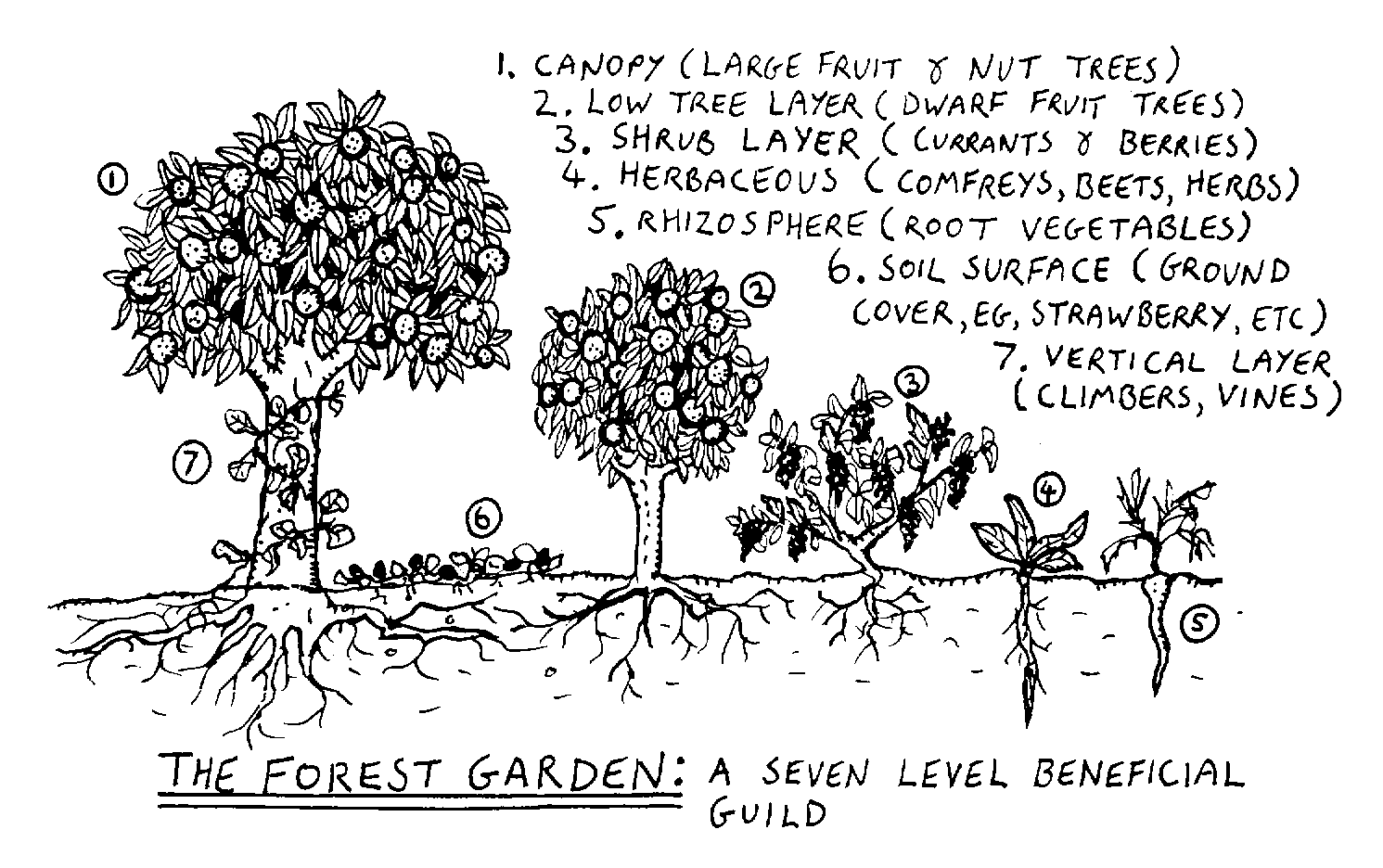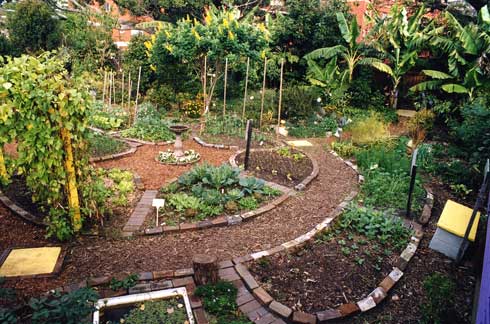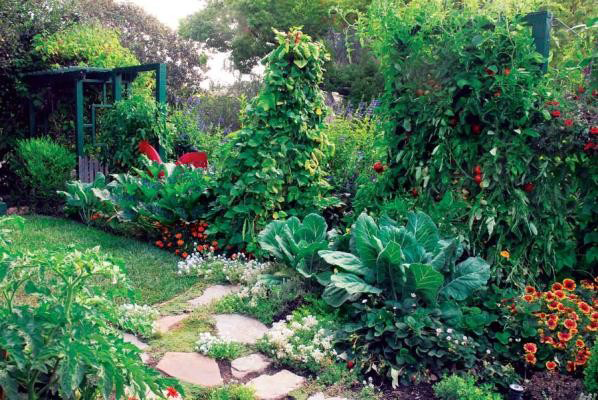Forest gardening or the creation of food forests are a method of creating sustainable ecosystems which consists entirely of useful plants for sustaining life including trees, nuts, herbs, bushes, fungi etc. all of which provide a useful yield to humans. By substituting the standard layers of a forest and making use of companion planting (plants which benefit each other within a proximity), plants can live out their lives as they do in a forest. Sustained by the delicate yet powerful balance of natural living cycles, the multiple layers of the food forest provide for each other the same way the layers of a natural forest do.
Food producing plants are but one piece of the forest gardening puzzle. Some plants are used to attract beneficial insects or birds. Others plants such as nitrogen fixing clover, act as soil builders, or simply help keep out weeds.Vines on trees, shrubs, add another layer of growing space for edible fruits such as kiwi and passion fruit. Plants support one another as they store energy in their roots for later harvest and winter storage and when properly arranged help retrieve and disperse deep lying nutrients for each other. Forest gardening is the creation of an entire system which results in an abundant forest of food.
Benefits
Often an over abundance of produce leads to an ability to share beyond necessity or to turn a small profit.
Non-reliance on monoculture methods increases chances of having the proper nutrition for your local population rather then reliance on a market with varying pricing and demand for a single product.
Fewer pests, less maintenance, no chemicals.
Create wildlife habitat.
Why Grow an Edible Forest Garden?
"While each forest gardener will have unique design goals, forest gardening in general has three primary practical intentions: High yields of diverse products such as food, fuel, fiber, fodder, fertilizer, 'farmaceuticals' and fun; A largely self-maintaining garden and; A healthy ecosystem." - edibleforestgardens.com
Food Forests in the United States
The Huntington Ranch - http://huntingtonblogs.org/theranch/2010/12/food-forest-intro/
The Huntington Ranch is a new experimental exhibit at The Huntington : Library, Art Collections and Botanical Gardens (http://www.huntington.org/default.aspx) located in San Marino, Ca. The low maintenance food garden technique is being applied, tested and scrutinized to help evolve the food forest/gardening best practices. Reducing maintenance, creating an ecosystem with active synergies and ensuring a measured increase in soil quality are some of the main goals in the exhibit.
Growing Food Forests in Seattle - http://www.urbanfarmhub.org/2010/03/growing-food-forests-in-seattle/
As a part of Transition Seattle - "an alliance of organizations and individuals who believe in living within the limits of the earth's resources, with healthier lifestyles, and in resilient, creative, just, and collaborative communities." This alliance goals and achievements include passing laws to secure land for sustainable food production and establishing these sustainable food production areas, organizing care taking and distribution. From food bearing street trees to urban food forests there is a growing movement in Seattle which wants to see it transformed into an urban food forest.
The Garden "From the ashes of the L.A. riots arose a lush, 14-acre community garden, the largest of its kind in the United States. Now bulldozers threaten its future." - http://www.imdb.com/title/tt1252486/
Traditional Examples
"Forest Gardens appear in many different societies in the wet tropics and go under various names including: Home gardens in Kerala in South India, Nepal, Zambia, Zimbabwe and Tanzania; Kandyan Forest Gardens in Sri Lanka; huertos familiares, the "family orchards" of Mexico; and pekarangan, the gardens of "complete design", in Java." -wikipedia.org/wiki/Forest_Gardening
Key Figures (inter-wiki links)
Robert Hart - http://en.wikipedia.org/wiki/Robert_Hart_(horticulturist)
Bill Mollison - http://en.wikipedia.org/wiki/Bill_Mollison
David Holmgren - http://en.wikipedia.org/wiki/David_Holmgren
Geoff Lawton - http://en.wikipedia.org/wiki/Geoff_Lawton
Sepp Holzer - http://en.wikipedia.org/wiki/Sepp_Holzer
Bibliography
Establishing a Food Forest the Permaculture Way starring Geoff Lawton
http://www.plant-trees.org/resources/training%20program/english/agfo_manual_english_small_noexam.pdf
http://edibleforestgardens.com/
Amazon Rainforest was Giant Garden City - http://www.telegraph.co.uk/science/science-news/3350474/Amazon-rainforest-was-giant-garden-city.html
Tropical Forest Gardening - http://www.waldeneffect.org/blog/Tropical_forest_gardening/
Chevron Found Guilty in Amazon Pollution Case - http://www.huffingtonpost.com/mitch-anderson/chevron-found-guilty-in-a_b_823864.html
Amazon Deforestation - http://www.greenpeace.org/international/en/campaigns/forests/amazon/
External Links
http://www.permaculture.org/nm/index.php/site/Permaculture-Food-Forest/
http://www.permaculture.org.au./
http://www.burlingtonpermaculture.org/infosheets/edibleforestgardensarticle.pdf



